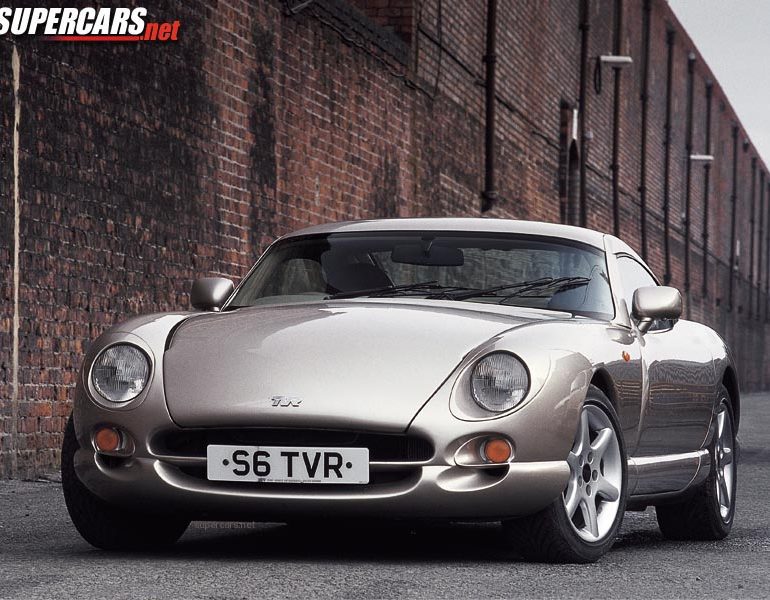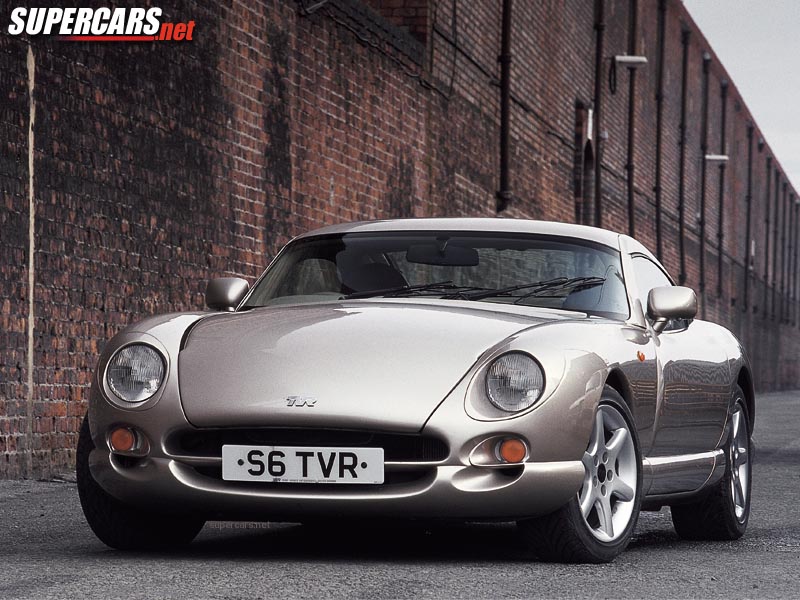2000 TVR Cerbera 4.2
The TVR Cerbera began life in the early summer of 1993 as a styling exercise by TVR’s team of designers, who were very quickly given the go-ahead to start building full scale models. They sculpted the car out of full-size blocks of foam rather than being constrained by the two dimensions of a paper sketch or the dehumanising aspects of design by computer.
A handsome Grand Tourer began to take shape and it was easy to see that the car would be a winner so a running prototype was prepared for the 1993 London Motor Show. Unencumbered by endless committees, TVR was able to complete the prototype in record time and the Cerbera was unveiled at the show. It was greeted with tremendous acclaim. Orders flooded in, a further 276 of them at the 1994 Birmingham Motor Show alone.
Since then, almost every aspect of the car has been improved. Originally, the Cerbera was designed to be powered by the TVR Power Rover based engines but it was decided that TVR’s own engine, the Speed Eight, would be a more suitable power plant. The Cerbera was the first roadgoing TVR to feature the Speed Eight engine.
This engine is quite remarkable in design in that it owes more to the current trend in racing engines than to anything that has ever been seen before in a road car. In other words, instead of basing a race engine on an existing road engine, TVR have developed an engine for the Cerbera out of a race engine. The result is that the Speed Eight has many features in it which would be more commonly found on an F1 engine. Examples of these are its extremely sophisticated water circulation system, its lubrication system which delivers oil at high pressure to the engine and at low pressure to the crankshaft and a block so rigid that it can be used as a stressed member. An all alloy engine with its eight cylinders arranged in a 75 degree Vee, the Speed Eight engine has more torque in its various specifications than any other normally aspirated petrol engine of equivalent size and weight.
At 121 kg, the engine is indeed lighter than the V8 F1 and F3000 engines with which it shares so many features. Many Speed Eight engine components are of extremely high quality such as the pistons and connecting rods which are forged and the camshafts which are rifle bored and are made of solid billet EN40B steel. The net result is that the Speed Eight has performed extremely well in the most gruelling test known to engineers: to give forty of them to TVR Tuscan racing drivers to try to blow up every weekend for the past five seasons.
Although sharing styling cues with the Chimaera, the Cerbera is a completely new car with new brakes, chassis, suspension and a different construction method. Introduced in response to overwhelming customer demand for a 2+2, the Cerbera has seen TVR return to a market sector that it has not inhabited since 1985. With the Cerbera’s interior, TVR have discarded conventional thinking and have created a dashboard binnacle in which all the instruments are right in front of the driver. The clock and the fuel gauge, visible through the steering wheel, and a fresh air vent are situated under the steering column and are adjustable for reach and rake with it. Mounted on the steering wheel are controls for the main beam, windscreen washers and wipers as well as the horn.
The Cerbera is more than a normal 2+2 in that, in terms of the configuration of its seating arrangement, it would be better described as a 3+1. The front passenger seat is able to slide forward further than normal, thereby freeing a substantial amount of extra legroom for the passenger sitting directly behind. Attention has been paid to the ease of access to the rear seats which in too many 2+2s is unnecessarily difficult. Therefore, the Cerbera’s doors are long enough to make getting into the back seats much easier.
Cerbera is pronounced Sir – burr – uh and is derived from the mythological beast, Cerberus, who was the brother of the Chimaera. In addition, in Italian, una cerbera is a frightening, fierce woman.
The Cerbera actually comes with three different engines. The Cerbera Speed Six was the first car to be fitted with TVRÃs own straight six and has softer suspension and higher profile tyres to give a more comfortable ride and less road noise in line with its grand touring design. Very much in the tradition of British sports cars of the sixties but with modern abilities, the Cerbera Speed Six is a coupe with a very British, very sporting nature.
The Cerbera 4.2 remains in production for those customers who prefer a V8 and the Cerbera 4.5 gives a range topping 420 bhp and 380 ft.lbs. of torque. Getting to 60 mph in 3.9 seconds, 100 in 8.1 and 150 in 17.9, the Cerbera 4.5 is one of the fastest road cars in existence. With larger brakes, modified suspension and larger wheels and tyres, the Cerbera 4.5 offers the handling and braking to match its performance, stopping from 100 mph in only 3.8 seconds. The 4.5 Cerbera also includes a Hydratrak speed sensitive differential as standard.
For the 2000 model year, lights, A pillars, roofline and seats were changed and lightweight bonnet, doors and bootlid were introduced on the Cerbera 4.5 .
Story by TVR Engineering Ltd
In Detail
| submitted by | Richard Owen |
| engine | V8 |
| valvetrain | 4-Valves / Cyl |
| displacement | 4280 cc / 261.2 in³ |
| bore | 86 mm / 3.39 in |
| stroke | 88 mm / 3.46 in |
| compression | 10.0:1 |
| power | 268.5 kw / 360.1 bhp @ 6500 rpm |
| specific output | 84.14 bhp per litre |
| bhp/weight | bhp per tonne |
| torque | 433.86 nm / 320.0 ft lbs @ 4500 rpm |
| driven wheels | Front Engine / RWD |
| front tires | 225/45ZR-16 |
| rear tires | 225/45ZR-16 |
| front brakes | Vented Discs |
| f brake size | x 294 mm / x 11.6 in |
| r brake size | x 273 mm / x 10.7 in |
| front wheels | F 40.6 x 19.0 cm / 16.0 x 7.5 in |
| rear wheels | R 40.6 x 19.0 cm / 16.0 x 7.5 in |
| curb weight | 1100 kg / 2425 lbs |
| front track | 1464 mm / 57.6 in |
| rear track | 1470 mm / 57.9 in |
| length | 4280 mm / 168.5 in |
| width | 1865 mm / 73.4 in |
| height | 1220 mm / 48.0 in |
| transmission | 5-Speed Manual |
| gear ratios | 2.95:1, 1.95:1, 1.34:1, 1.00:1, 0.80:1, :1 |
| top speed | ~289.7 kph / 180 mph |
| 0 – 60 mph | ~4.2 seconds |
| 0 – 100 mph | ~9.9 seconds |






